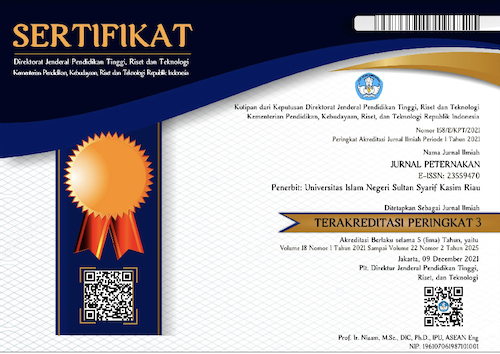EVALUASI KANDUNGAN BAHAN KERING, BAHAN ORGANIK DAN PROTEIN KASAR PELEPAH SAWIT FERMENTASI DENGAN PENAMBAHAN SUMBER KARBOHIDRAT
Abstract
This research was aimed to evaluate the content of dry matter, organic matter and crude protein of palm oil fronds as an alternative feed substitution of native grass, which was enhanced through fermentation biotechnological innovation with the addition of carbohydrate soluble. Fermentation palm oil frond done using local microorganisms resources rumen content and
Lactobacillus. The experimental design used was factorial on complete randomized design 2x3 with 3 replication each treatment. Factor A were the source of inoculums fermentation, A1=. lactobacillus, A2= local microorganisms resources rumen content. Factor B were the source of soluble carbohydrates where B1 = without a carbohydrates, rice B2 = e bran, B3 = tapioca starch. Parameters measured were content of dry matter, organic matter and crude protein of palm oil fronds. The results of this research showed that no interaction effect between the source of microorganisms with carbohydrates, and the treatment had no effect (P > 0.05) on dry matter content. No effect Factor A for all parameters while the factors B Influential were significantly (P < 0.01) on the content of organic matter and crude protein. The highest crude protein content in the fermented palm oil fronds with a source of carbohydrates from rice bran (6.55%)
Keywords
Full Text:
PDFReferences
AOAC, 1995. Official Methods of Analysis of The Association Agricultural Chemists. 14 th
Ed., Washington DC
Astuti.T, Yurni. S. Amir, Gusni Yelni, and Isyaturriyadhah. 2014. The Result of
Biotechnology by Local Microorganisms to Banana Peel on Rumen Fluid Characteristics as Ruminant Feed. Journal of Advanced Agricultural Technologies. Vol. 1 (1): 28 – 31
Astuti, T., Y. Amir, Irdawatiand U. Santoso. 2016. Nutritional improvement of palm oil
fronds for ruminant feedstuffs using a local biotechnological approach. Pak. J. Nutr.,
:450–454.
BPS, 2014. Staistik perkebunan Indonesia 2013-2015 kelapa sawit. , (December 2014).
Luh, B., 1991. Rice Utilization Vol II. Van Nostrand Reinhold, New York
Richana, N dan Sunarti, T.C., 2004. Karakterisasi Sifat Fisikokimia Tepung Umbi dan
Tepung Pati dari Umbi Ganyong, Suweg, Ubi Kelapa, dan Gembili. Jurnal
Pascapanen Vol. 1. No. 1. Hal: 29-37.
Simanihuruk K, Junjungan Dan Andi Tarigan. 2007. Pemanfaatan pelepah kelapa sawit
sebagai pakan basal kambing kacang fase pertumbuhan. Proseding Seminar Nasional Teknologi Peternakan dan Veteriner 2007. Hal 417-425
Wajizah, S., Samadi., Usman, Y., Mariana, E., 2015. Evaluasi Nilai Nutrisi dan Kecernaan In
Vitro Pelepah Kelapa Sawit (Oil Palm Fronds) yang Difermentasi Menggunakan Aspergillus niger dengan Penambahan Sumber Karbohidrat yang Berbeda. Agripet : Vol (15) No. 1 : 13-19
Zakaria. Y, Cut Intan Novita1 dan Samadi. 2013. Efectivitas fermentasi dengan sumber
substrat yang berbeda terhadap kualitas jerami padi. Agripet : Vol (13) No. 1: 22-25
Zumael, Z. 2009. The Nutrient Enrichment of Biological Processing. Agricmed, Warsaw
DOI: http://dx.doi.org/10.24014/jupet.v14i2.4247
Refbacks
- There are currently no refbacks.
Jurnal Peternakan has been accredited by Sinta 3 : Number 158/E/KPT/2021
Starting from Vol. 18 No. 1 Year 2021 to Vol. 22 No. 2 Year 2025
Jurnal Peternakan Indexed By:
Editorial Office:
Jurnal Peternakan
Faculty of Agriculture and Animal Science, State Islamic University of Sultan Syarif Kasim Riau.
H.R. Soebrantas street KM. 15,5 Panam – Pekanbaru city.
E-mail: jurnal.peternakan@uin-suska.ac.id
ejournal: http://ejournal.uin-suska.ac.id/index.php/peternakan

Creation is distributed under the Creative Commons Attribution 4.0 International License. View Mystats














